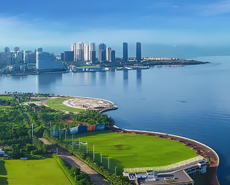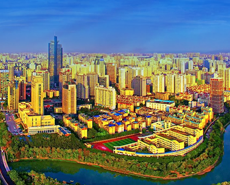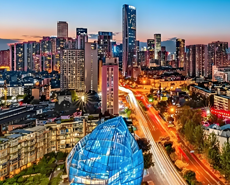
Liquid cathode electrolytic cell to lead the process of rare earth molten salt
----Interview with Ning Dongjie
President
Baotou Pulite New Materials Co.
President
Baotou Pulite New Materials Co.
Built on April 11th, 2021, Baotou Pulite New Materials Co., which owned a planned annual production capacity of 3,000t of rare earth metal products, mainly engages in R&D, processing and sales of rare earth metals and alloys. The plant put in to production since November of 2020 and would fulfill the whole project of PrNd mischmetal, cerium metal, lanthanum metal, LaCe mischmetal and ferrogadolinium by the end of 2021.
Asian Metal: Hello, Mr. Ning! Thank you for accepting our interview. Could you please briefly introduce your company and your main business?
Mr. Ning: Built on April 11th, 2021, Baotou Pulite New Materials Co. is a private joint-stock company with a registered capital of RMB30 million (USD4.57 million) and a total investment of RMB101 million (USD15.40 million). The company mainly engages in R&D, processing and sales of rare earth metals and alloys. The company, which owned a planned annual production capacity of 3,000t of rare earth metal products, is located in Rare Earth New Materials Industrial Park of Jiuyuan Development Zone in Baotou city and covers an area of 40 mu. After three years’ plan, design and construction, the company put PrNd mischmetal and cerium metal into production in November 2020. Now the company has an experienced management and technical team with solid theory and has been engaged in rare earth pyrometallurgy industry for many years. With the advanced, reasonable, intensive advantages on overall planning, the layout of the workshop and the design of environmental protection and public auxiliary facilities, the company already laid a solid foundation for its next innovative, efficiency and rapid development.


Asian Metal: Would you like to share us your career in rare earth industry? As the pioneer of PrNd mischmetal R&D and the promoter of the market, can you introduce the history and process of PrNd mischmetal application?
Mr. Ning: After I graduated from university since 1987, I worked in Baotou Research Institute of Rare Earths and then engaged in the rare earth career and destined to have an indissoluble bond with rare earth. I started to work in the industrial experimental workshop of NdFeb Magnet after we imported equipment from Japan. At that time, the equipment and technology for NdFeB industrial production were not mature, but it helped me a lot as an undergraduate that just participated in job, especially enhancing the comprehensive understanding of rare earth metals that used in NdFeB magnet production. Afterwards, with the development of NdFeB magnet industry in China, the market got more competitive and our NdFeB magnet workshop also experienced changes, so I built my own rare earth metal plant with several friends and started to offer rare earth metals and alloys to NdFeB magnet industry. At that time, the rare earth raw material that used for NdFeB industry was just neodymium metal, without extra rare earth metals and alloys, such as cerium metal, ferrogadolinium and PrNd mischmetal. However, as the majority contents of rare earth concentrate in Baotou are lanthanum and cerium, which account for around 75% of total, and we also need to separate praseodymium from the concentrate. Therefore, the separation process was long and the production costs stayed high, and most rare earth resources besides neodymium element could not be made good use. As a result, we tried to produce PrNd mischmetal and promoted to use into NdFeB magnet. However, as there were only a few NdFeB magnet plants at that decade and all NdFeB magnet plants earned high profits, so they did not intend to take risks to use PrNd mischmetal instead of neodymium metal. After months’ of efforts, we persuaded a magnet plant in Shanxi to have a try and made the success, so that we opened the era of NdFeB using PrNd mischmetal rather than neodymium metal.
Asian Metal: What's your opinion on Chinese PrNd mischmetal demand in the coming three years?
Mr. Ning: Generally Speaking, the market prices depend on the relationship between market supply and demand. The balance of supply and demand sets the base of steady prices. The sharply ups and downs of market prices would harm the development of NdFeB magnet industry chain. Seen from the supply side, the PrNd oxide supply originates from three aspects, such as the rare earth concentrates in China, the recycled magnet waste and the imported rare earth concentrate from abroad. In terms of the demand side, driven by the development trend of energy saving, environmental protection and intelligent manufacturing, wind power generation, new energy vehicles, electric vehicles, advanced and intelligent manufacturing, intelligent home appliances and high-end electronics provide a huge market space for NdFeB magnet industry. In 2020, the global production of NdFeB has exceeded 200,000t, According to a conservative estimate, the average annual growth rate of NdFeB market during the 14th Five-Year Plan period would reach 5% at least, and the growth rate of raw material demand would achieve more than 5%.


Asian Metal: How about your project’s construction and progress of 3,000t of rare earth metals and alloys?
Mr. Ning: We already finished the phase I of 1,500t of rare earth production by Q4 of 2020, including the construction of office building, workshops and other supporting facilities. We put rare earth metal in to production since November of 2020. Now we own 21 molten salt electrolytic cells, including 15 electrolytic cells for PrNd mischmetal and six electrolytic cells for cerium metal. Currently, our company produces around 90t of PrNd mischmetal and about 30t of cerium metal a month. We already carried out the phase II construction. We invested RMB2 million (USD0.30 million) to equip the environmental protection facilities for phase II and we would have finished this job before the end of this April. By this October, we would finish the construction of the whole project and totally put into production by the end of 2021. By then, we would own a total annual production capacity of 3,000t for PrNd mischmetal, cerium metal, lanthanum metal, LaCe mischmetal and ferrogadolinium.
Asian Metal: In terms of PrNd mischmetal production, what are differences between mainstream molten salt electrolytic cells of 6,000A, 8,000A and 15,000A? How do you think when you chose the type of molten salt electrolytic cells?
Mr. Ning: The current 6,000A, 8,000A and 15,000A molten salt electrolytic cells have some differences innumber of cathode and volume of monthly output, but they are similar in most parts. From the point of view of the cathode number, the electrolytic cells of 6,000A and 8,000A are all single cathode cells, and the electrolytic cells of 15,000A have been used by individual enterprises with double cathodes and triple cathodes. In addition, the higher working current, the higher monthly outputs. However, the chosen of the electrolytic cells are usually restricted by many factors such as the way of metal discharging, operability and current density design. At present, 6,000A and 8,000A electrolytic cells are more mature, and the process of 15,000A is still being explored. If the automatic metal discharging technology makes a breakthrough, there will be higher current electrolytic cells. Taking PrNd mischmetal production as an example, the monthly output of a 6,000A electrolytic cell records 4.3-4.5t, compared with 5.2-5.3t for the 8,000A electrolytic cell which are widely used in the rare earth production. Considering production efficiency and operability, we chose the mature 8,000A electrolytic cell and equipped with 12,000A power supply cabinet, while the working electric current ranges from 7,300A to 7,500A and our monthly output achieves around six tons. Now we are making efforts to enlarge the monthly output to about 6.5t. Besides around 80% efficiency for the working electric current, we also chose 12,000A electrolytic cell for the potential development in the future. Besides, a few companies also use the 15,000A electrolytic cell, but the 8,000A electrolytic cell are more flexible and high efficient. For example, we need two employees to handle 15,000A electrolytic cell at the same time, and there are usually 8 people to make up a work team and the work team produce about 15t a month, while one employee usually handles three electrolytic cells of 8,000A and there are three people to build a work team and the output could reach 18t a month.
















